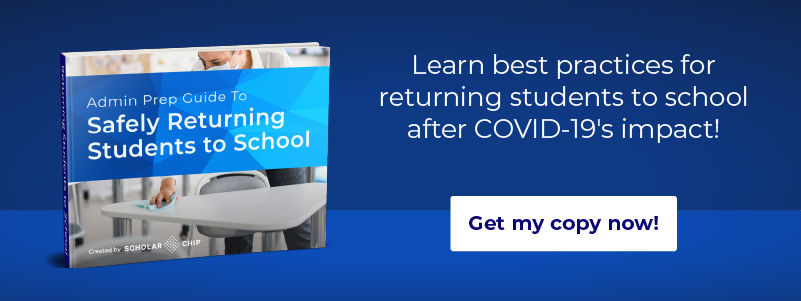Before the COVID-19 pandemic, approximately seven in ten parents admitted that they had sent a sick child to school at least once. This isn’t that surprising. If children were kept home from school every time they had the sniffles or a mild cough, they might miss days and weeks each year!
However, this attitude toward children’s sickness needs to change. Fortunately, children are often not susceptible to life-threatening cases of COVID-19. But even if a child only has mild symptoms, they could still pass on the virus to other children, staff and faculty, and community members.
Because COVID-19 is tremendously contagious, the best thing that parents can do is keep their sick child home from school, even if they don’t know if the child’s symptoms are related to the virus. But school administrators know that this may not always happen. Children may still come to school sick or develop worse symptoms throughout the day. However, in the age of COVID-19, it’s no longer acceptable to tell the student to wait until the last bell rings.
Instead, we’ve compiled a list of strategies for developing a comprehensive response to sick students.
1. Teach Students Healthy Habits
The most important thing that you can do for students is to teach them how to prevent spreading or contracting the virus:
- Teach students to wash and disinfect their hands at the stations you’ve set up at the school.
- Require students to wear masks when they’re in close contact with others.
- Remind students that they need to keep six feet away from others at all times.
- Instruct students not to share items like pencils or glue.
Students will likely have varying degrees of familiarity with these expectations, but these are essential habits that will protect them if a classmate does get sick.
2. Encourage Parents to Take Illness Seriously
As mentioned, parents may not always take their children’s sniffles or coughs seriously enough to keep them home from school. Now, it’s important to communicate with parents about the seriousness of the disease.
First, parents must watch for COVID symptoms in their children. These might be mild: a fever, difficulty taking deep breaths, or a cough. It’s your job to remind parents that now is a time to be overly cautious.
Also, encourage parents to have plans in place for if their children get sick. For instance, who will stay at home with the child? Is there a room for the sick child to recuperate so as not to infect other relatives? If parents are scrambling for ways to deal with their sick child, they may be more likely to send a mildly-ill child to school.
3. Isolate Sick Students until They Can Be Sent Home
If you have a sick student on your campus, your priority is to quickly ensure that they’re separated from students and staff. Nurses should have a place where sick students can be isolated until they can be picked up by their parents or guardians.
4. Consider the CDC’s Guidelines to Limit Transmission
If a student at your school is diagnosed with COVID-19, the CDC has provided guidelines that instruct administrators how to respond:
- Notify health officials in your community.
- Dismiss the campus for two to five days while health officials can develop appropriate plans.
- Encourage students, faculty, and staff to isolate themselves as much as possible.
- Communicate with stakeholders while protecting the sick student’s privacy.
- Clean and disinfect your campus.
- Connect with health officials to consider if in-person learning should be discontinued for an extended period.
5. Keep Track of Sick Students
It’s also essential to have a contingency plan for notifying other students, staff, and parents if a sick student does come to your campus.
Contact tracing has become a crucial strategy for minimizing the spread of COVID-19. If a student contracts the virus, a contact tracing team will inform the individuals with whom the infected student came into contact. For instance, if the student sat in a classroom with twenty other students, the team would inform all those individuals.
While many contact tracing teams focus on interviewing infected people, using technology to track students before infection is a more effective strategy. ScholarChip’s tools can simplify this kind of tracking.
First, students should be given a One Card, a card unique to them that can be used to open doors in and around campus. Next, install Secure Access door portals on every door: the entryway, classrooms, shared areas, etc. Students will tap their cards on these portals every time they enter a new space. This way, if a student is infected with COVID-19, you can use this information to not only track their whereabouts but also have a reliable list of everyone with whom they came into contact at your school. ScholarChip’s Admin Portals can keep track of this useful information.
Your job is to prepare for the eventuality that one of your students will get sick. That’s why it’s important to plan ahead by preparing parents and students, minimizing exposure on campus, and procuring technology for improved student tracking. With all these steps in place, you’ll reduce the risk of COVID-19 considerably.
ScholarChip offers unique holistic school safety services based on CDC guidelines to help schools reopen amidst growing health concerns. Through our advanced technology, built and designed for the K-12 environment, schools can identify risk and mitigate the spread of infection. Our solution includes fever screening, visitor questionnaires, symptom and vaccine tracking, in-school contact tracing, alerts, and notifications. Learn more about our advanced COVID-19 solutions or request a reopening strategy session today!


